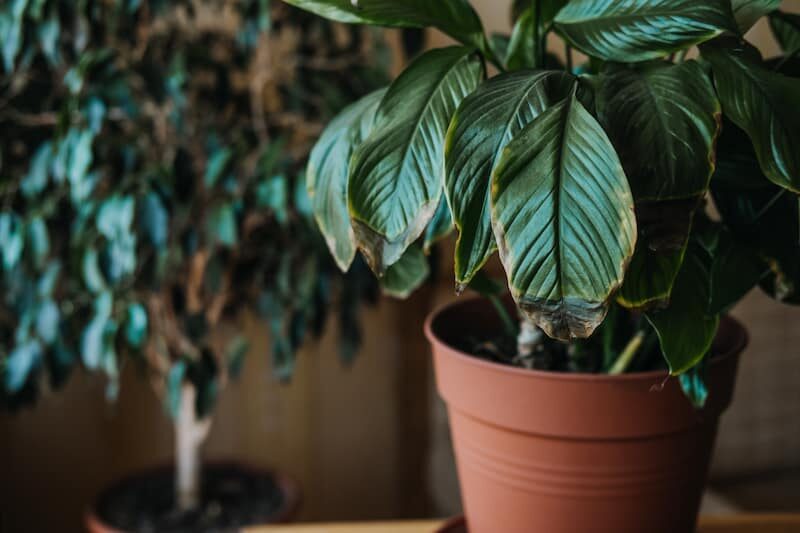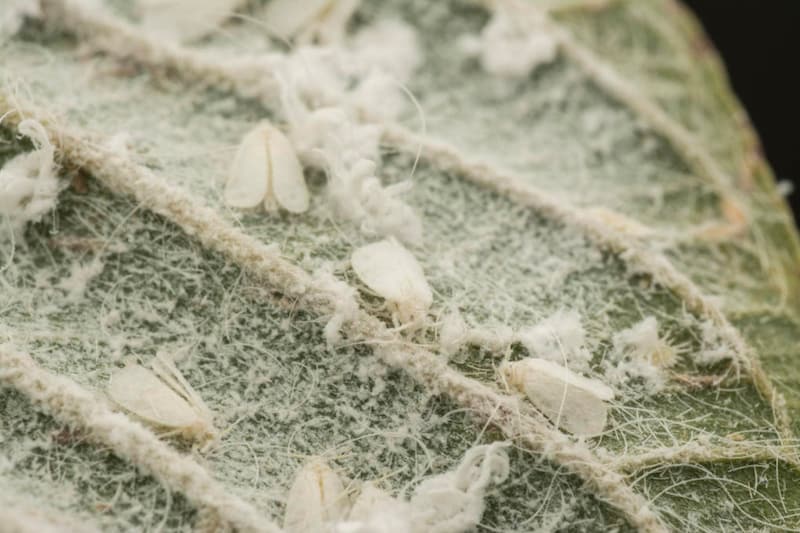A Peace Lily drooping can indicate all kinds of problems for your plant. When a Spathiphyllum wilts, it may appear as it’s dying, but with care adjustments, you can revive your peace lily and its leaves will point up again.
Drooping is not necessarily synonymous with dying. It can be a sign that your houseplant is thirsty or that it needs a bit of shade. Let’s consider some of the primary causes of a drooping peace lily in this article.
- Learn all about Peace Lily Plants and Caring for Them.
Reasons Why Your Peace Lily Is Drooping
When one notices a peace lily drooping, the first thought will be that the plant needs water. This is true in certain cases, but it’s not the only reason. Reasons for a wilting peace lily include overwatering, excessive sun exposure, infections, infestations, and more.
This makes it crucial that you identify the reason before treating your plant to prevent further damage.
Watering Issues That Lead to Peace Lily Drooping
Improper watering is probably the most common reason behind a drooping peace lily. However, it’s just as likely that overwatering is to blame as underwatering.
How Underwatering a Peace Lily Causes Drooping
The lack of water will cause your plant to dry out and the foliage will begin to wilt. Droopy leaves are often the first sign that your plant needs a drink. Leaves will wilt because of a lack of moisture. Yellow leaves will be a clear indication of underwatering.
You can easily determine if underwatering is the culprit because the soil bed will be dried out. Seriously affected leaves that have changed color will require pruning. If the leaves are still green and just wilting, within a day of watering they should rebound and spring back to life.

How Overwatering a Peace Lily Causes Drooping
When looking at a wilting plant, it may not cross your mind that overwatering can be the cause, but it can and does. When a plant is overwatered, there’ll be soggy and waterlogged soil, practically drowning the plant’s root system.
Roots need oxygen as much as they require water. When they are left to sit in excess water, they drown, because oxygen is unable to reach roots.
The roots cannot absorb nutrients vital to their survival when sitting in water or photosynthesize, and the leaves begin to droop. This is usually a result of poor and inadequate drainage with the container.
Overwatering may also exhibit other symptoms together with drooping. These include:
- Black-tipped roots
- Brown leaf tips and edges
- Brown spots on stems
- Lower, yellow leaves on the plant
Overwatering can open the door to diseases such as root rot, Phytophthora, Cylindrocladium, and Pythium.
In the case of overwatering, you’ll need to repot your plant. You should remove the peace lily from soggy soil and throw out the old soil. Allow the roots to dry and then repot your peace lily in fresh, well-draining soil.
Do not resume watering for a couple of days. When repotting, make sure that your pot has a sufficient number of drainage holes.
Too Much Sunlight Causes Peace Lily Drooping
The native habitat for peace lilies is tropical rainforests. They grow close to the ground, meaning that they do not receive direct sunlight, but rather dappled sunlight underneath a natural canopy of trees. This is one of the reasons why they easily adapt to medium and low-light environmental conditions.
As a result, these tropical plants are used to bright indirect sunlight. if they are over-exposed to too much direct sunlight, the foliage will begin to droop because the transpiration rate will be higher, and the plant will lose moisture too quickly.
For your peace lily to thrive, it needs to receive indirect light and even partial shade. Leaves may begin to show signs of scorching when it receives too much direct light.
Move your plant to a position that does not expose it to direct sunlight. Remove damaged leaves, so it doesn’t affect other green leaves.
Pest Infestations Cause a Peace Lily to Droop and Wilt
Peace lilies are not susceptible to all pests, but they are at risk for a few. Among problematic pests are mealybugs and spider mites. The presence of these pests should not be ignored because they can do extensive damage to peace lilies.
Mealybugs are sap-sucking bugs that especially like peace lilies. They attach themselves to the plant to suck the sap. The plant will begin to dehydrate, and the foliage will droop.

If your plant is drooping, examine it carefully. Look for fluffy white deposits on the stem that resemble small cotton balls. If they are present, your plant has a mealybug infestation. Because these insects live in colonies, your plant is unlikely to have only one.
To remove the mealybugs on your peace lily, follow these steps. Dip a cotton ball in alcohol and clean the plant, removing any insects. You can also spray your plant with a 70% solution of isopropyl alcohol which is safe for your plant. Spray the entire plant thoroughly.
The following day, rinse your plant in the shower to remove dead insects. An alternative to alcohol is insecticidal soap. The plant should be sprayed completely with insecticidal soap to take care of the insect infestation.
Temperature Fluctuations Lead to Peace Lily Drooping
As natives of tropical rainforests, peace lilies flourish in a temperature range of65° to 85°F, making them ideal indoor plants. In the evenings they can survive a temperature drop of 10°F down to 55°F, but not much more.
When indoor temperatures rise above or drop below the plant’s comfort zone, leaves will begin to droop and even die. Any type of heating or cooling instrument will cause temperature fluctuations in the immediate vicinity.
To avoid temperature fluctuations, keep your plant away from drafty windows, doors, and hallways. Never place your plant near a heating unit, an air conditioner, or near vents. They also should not be near fireplaces in use.
Should your plant begin to droop, and you suspect temperature fluctuations as the cause, move your plant to an area subject to less potential temperature change. After several days, check your plant for improvements. If your plant is still drooping, look for another cause.
Poor Soil Conditions Cause Peace Lilies to Droop
A standard quality potting soil should allow your peace lily to thrive. There are, however, soil conditions that can exert a negative influence.
If the soil is waterlogged, because it is overwatered or not draining properly, it will suffocate your plant’s root system and lead to root rot. The plant will not be able to receive sufficient oxygen or absorb sufficient nutrients.
Another soil problem is when the soil bed drains too rapidly. In this case, the plant will also not be able to absorb nutrients or sufficient water for survival.
When potting your peace lily, you want fresh soil and take care to avoid these types of soil:
- Clay soil leads to waterlogging. Clay soil does not absorb and drain water easily or rapidly.
- Sandy soil will drain too rapidly, not permitting the plant to adequately absorb water or nutrients.
If you suspect the soil bed is the reason for a peace lily drooping, repot your plant in quality potting soil amended with perlite, bark chips, or peat moss.
Low Humidity Levels Cause Peace Lilies to Droop and Wilt
As a tropical plant, the peace lily likes high humidity. In environments with dry air or low humidity, your leaves may begin to droop. Your plant may also exhibit other symptoms of a lack of humidity, including
- Brown leaf edges
- Crispy leaves
- Yellow leaves
If you notice any of these signs together with wilting, you may have a low humidity problem.
To increase the humidity level where the plants are located, you have a few options.
- Use a plant humidifier in the area.
- Mist your plant several times a week.
- Group plants together to raise the surrounding humidity.
- Create a pebble tray and place your plant pot on top of it.
To create a pebble tray, fill a tray with pretty pebbles, stones, or rocks. Fill the tray with water then set your peace lily on top. The drainage holes of the container should not come into contact with the water in the tray. A tray will raise the humidity around the plant as the water evaporates.
Diseases Cause Peace Lily Drooping and Wilting
A peace lily is susceptible to Cylindrocladium or root rot. Leaves and stems will change color, and leaves will wilt. The roots will appear wet and mushy.
If this is the case, remove the plant from its pot. Remove all the old soil. Trim away damaged and affected roots. Dip the roots in a fungicide or spray them with one. Replant your peace lily in a new container with fresh potting soil.
Throw out the old soil, so it doesn’t contaminate other plants and grass. All gardening tools used and the old container need to be sterilized to remove any remaining fungal contaminants. This disease is usually brought on by overwatering.
Peace Lily Drooping Leaves Final Thoughts
Your peace lily can droop for a variety of reasons. However, there are solutions to reverse the condition. Examine your plant carefully and treat your peace lily based on the cause.
Read more about the peace lily plant and caring for it:

